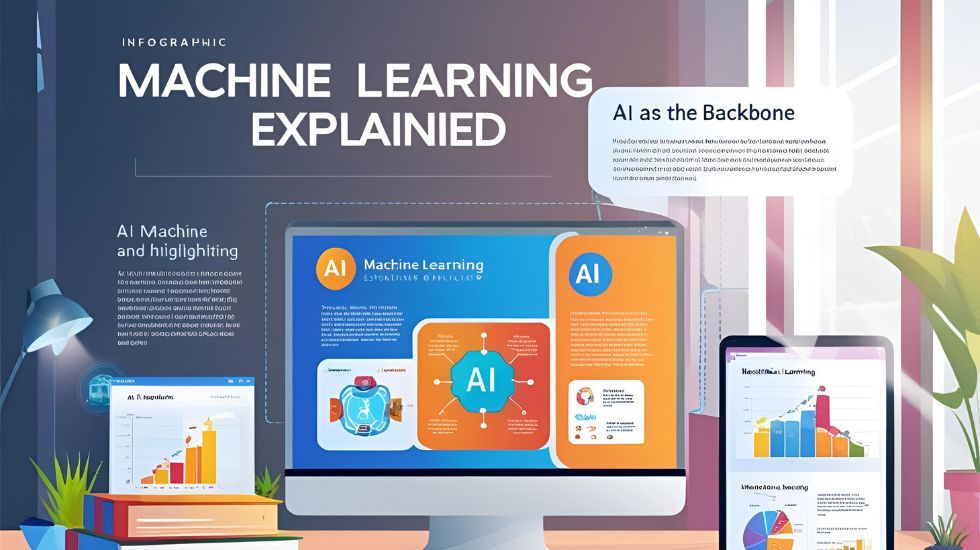
Artificial Intelligence (AI) आज की दुनिया में हर जगह छाया हुआ है – चाहे वो self-driving cars हों, online shopping के recommendations हों, या healthcare में diagnosis। लेकिन AI का असली जादू इसके एक core component से आता है: Machine Learning (ML). Machine Learning को AI की backbone कहा जाता है, क्योंकि ये machines को data से सीखने और smart decisions लेने की power देता है। लेकिन Machine Learning आखिर है क्या? ये कैसे काम करता है? इस article में हम ML को आसान भाषा में explain करेंगे और समझेंगे कि ये AI का heart क्यों है। तो चलिए शुरू करते हैं!
Machine Learning क्या है?
Machine Learning एक ऐसी technology है जो computers को बिना explicitly programmed किए data से सीखने की ability देती है। ये AI का एक हिस्सा है जो patterns ढूंढता है और predictions करता है।
- उदाहरण: अगर आप Netflix पर movies देखते हैं, तो ML आपके taste को समझकर suggestions देता है।
- महत्व: ML के बिना AI static और limited रहता।
अब जानते हैं कि ML कैसे काम करता है और AI को power क्यों देता है।
1. Data से Learning: ML का Base
ML का core idea है data से सीखना।
- कैसे काम करता है?
- ML algorithms को बड़ी मात्रा में data (जैसे images, text, numbers) दिया जाता है।
- ये data में patterns और relationships ढूंढता है।
- उदाहरण: मान लीजिए आप spam emails filter करना चाहते हैं। ML को thousands of emails दिखाए जाते हैं – कुछ spam, कुछ normal। ये patterns सीखता है और future में spam को detect करता है।
- फायदा: Human intervention के बिना machines smarter बनते हैं।
SEO टिप: “Machine Learning basics in Hindi” सर्च करें तो आपको और simple explanations मिल सकते हैं।
2. Types of Machine Learning
ML को तीन main categories में divide किया जाता है:
- Supervised Learning:
- Labeled data से सीखता है (input-output pairs)।
- जैसे: House prices predict करना square footage और location से।
- Unsupervised Learning:
- बिना labels के data में patterns ढूंढता है।
- जैसे: Customer segmentation ecommerce में।
- Reinforcement Learning:
- Trial-and-error से सीखता है, rewards के आधार पर।
- जैसे: Robots को walking सिखाना।
- उदाहरण: Google Maps का traffic prediction supervised learning से होता है।
- फायदा: Different problems के लिए flexible solutions।
3. Algorithms: ML का Engine
ML algorithms वो mathematical models हैं जो data को process करते हैं।
- Popular Algorithms:
- Linear Regression: Trends predict करने के लिए।
- Decision Trees: Classification (yes/no decisions) के लिए।
- Neural Networks: Complex tasks (image recognition) के लिए।
- कैसे काम करते हैं?
- Data को input लेकर output generate करते हैं।
- Errors को minimize करने के लिए खुद को adjust करते हैं।
- उदाहरण: Neural networks से self-driving cars obstacles detect करती हैं।
- फायदा: Accuracy और scalability।
4. Training और Testing: ML का Process
ML models को तैयार करने के लिए training और testing जरूरी है।
- Training:
- Model को data feed किया जाता है ताकि वो सीख सके।
- जैसे: Photos से cats vs dogs पहचानना सिखाना।
- Testing:
- New, unseen data पर model की accuracy check की जाती है।
- उदाहरण: Speech recognition में ML को voices सुनाकर trained किया जाता है।
- फायदा: Real-world performance improve होती है।
SEO के लिए “Machine Learning training process in Hindi” useful हो सकता है।
5. AI में ML की Backbone Role
ML के बिना AI अधूरा है। ये AI को intelligence और adaptability देता है।
- क्यों जरूरी है?
- Prediction: Weather, stock prices।
- Automation: Chatbots, robotics।
- Recognition: Face ID, voice assistants।
- उदाहरण: Alexa आपकी voice को ML से समझता है और responses देता है।
- फायदा: AI को dynamic और human-like बनाता है।
ML के Pros और Cons
- Pros:
- Fast और accurate predictions।
- Scalable solutions।
- Automation से time saving।
- Cons:
- Data dependency (quality data चाहिए)।
- High computational cost।
- Bias risk (garbage in, garbage out)।
इन pros को leverage और cons को manage करना जरूरी है।
India में ML का Impact
India में ML तेजी से adopt हो रहा है।
- Applications:
- Ecommerce (Flipkart recommendations)।
- Healthcare (disease prediction)।
- Agriculture (crop yield analysis)।
- उदाहरण: Reliance Jio ML से network optimization कर रहा है।
- Challenge: Skill gap और infrastructure।
Future में ML India के tech landscape को shape करेगा।
Individuals के लिए ML का मतलब
- Daily Life: Smartphones, apps में ML everywhere है।
- Learning: Free courses (Coursera, YouTube) से ML सीख सकते हैं।
- Career: Data science, AI jobs में opportunities।
Businesses के लिए ML का फायदा
- Efficiency: Operations automate होते हैं।
- Insights: Customer behavior समझने में मदद।
- Innovation: New products और services।
Real-World Example
मान लीजिए एक online store है।
- Problem: Customers products ढूंढने में confuse होते हैं।
- ML Solution: ML browsing data से patterns सीखता है और “best deals” suggest करता है।
- Result: Sales 20% बढ़ते हैं, customers खुश।
Challenges और Solutions
- Challenge 1: Data Quality
- Solution: Clean और diverse datasets use करें।
- Challenge 2: Cost
- Solution: Cloud platforms (AWS, Google Cloud) से शुरू करें।
- Challenge 3: Complexity
- Solution: Simple tools (Python libraries) से शुरुआत।
Beginners के लिए सलाह
अगर आप ML सीखना चाहते हैं:
- Start Simple: Python और basic algorithms सीखें।
- Practice: Small projects (spam filter) बनाएं।
- Stay Updated: ML news (Towards Data Science) follow करें।
निष्कर्ष
Machine Learning AI की backbone है – ये data से सीखता है, predictions करता है, और AI को smart बनाता है। Types, algorithms, और training process से लेकर real-world applications तक, ML हर industry को transform कर रहा है। हां, challenges जैसे data और cost हैं, लेकिन सही approach से ML का maximum फायदा उठाया जा सकता है।
तो ML को समझें, इसके power को explore करें, और AI के future का हिस्सा बनें। Technology को embrace करें और इसके साथ grow करें। Happy learning!

Leave a Reply